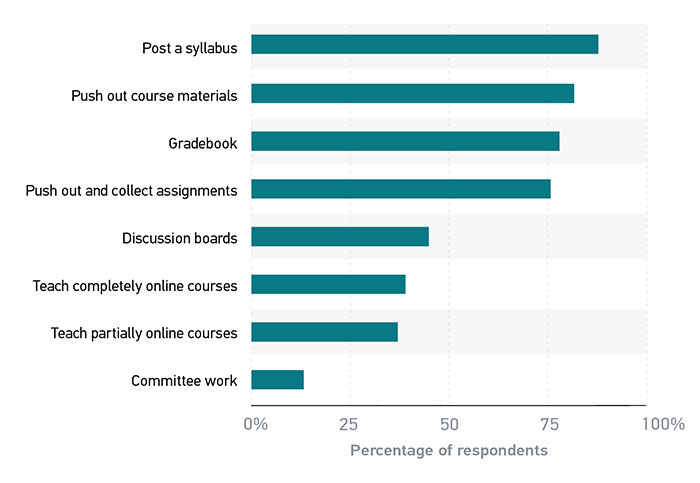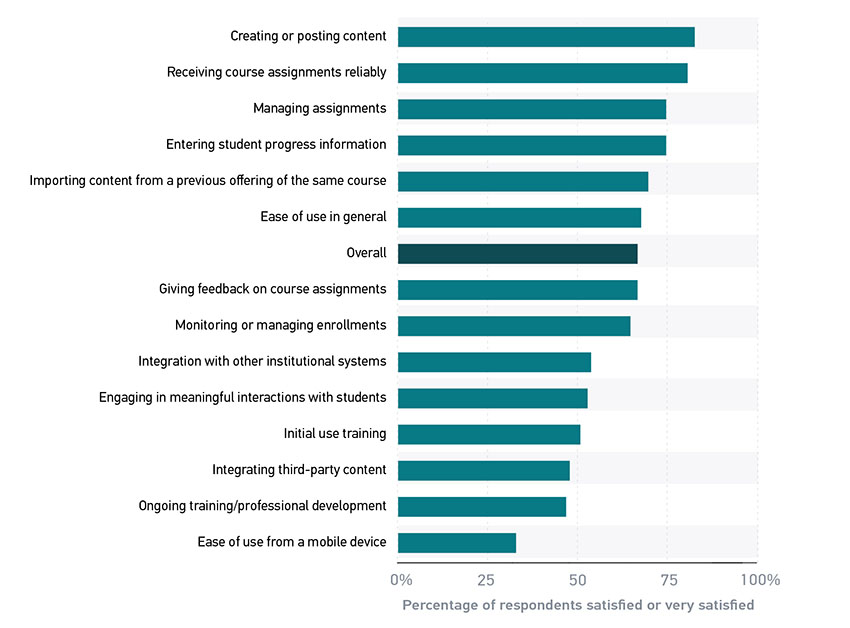LMS
Use of the LMS
LMSs are universal in higher education, having achieved near-saturation of the market with nearly all institutions having at least one in place.1 Therefore one might expect the LMS market to be quite mature, but this is not entirely the case. As Phil Hill has reported,2 the LMS market has undergone a great deal of change over the course of two decades, and this change continues to this day as new products emerge and existing products merge. Looking across the 2014, 2015, and 2017 faculty studies, Canvas continues to gain market share, Blackboard continues to lose market share, and homegrown systems are similarly on the decline.
Regardless of the LMS that an institution uses, the uses to which faculty put the LMS are remarkably consistent both across institution types and across time. Pushing out information has been the most common use of the LMS across the 2014, 2015, and, as shown in figure 8, the 2017 faculty studies. In the 2017 study, this category was decomposed for the first time into a set of types of information that a faculty member might want to push out: the syllabus, handouts, and assignments. All three of these were among the most common uses of the LMS, with three-quarters or more of faculty using the LMS for those purposes. Rounding out the set of the most common uses of the LMS is the companion to pushing out assignments: using the gradebook.3

The most common faculty uses of the LMS are all operational, course management functions. These are functions that require little or no interaction between the instructor and the students. Even pushing out and collecting assignments and using the gradebook are asynchronous and do not necessarily involve interaction. Use of the discussion boards is necessarily interactive and is far less common. One might expect faculty who have taught more online courses to make greater use of the interactive functionality of the LMS, but somewhat surprisingly this was not the case.
Satisfaction with the LMS
No single LMS has emerged as dominant, as new products continue to emerge and existing products to merge. Even the fundamental questions of whether institutions opt for an in-house or a vendor-managed LMS4 and whether that LMS is proprietary or open source5 remain open. Yet LMSs are universal, with nearly all institutions having at least one in place,6 and most LMSs have similar functionality.
Despite the ongoing changes in the LMS market and regardless of which LMS an institution uses, faculty satisfaction with LMSs and their functionality has changed little over time. Specifically, the findings about satisfaction with the LMS look remarkably similar across the 2014, 2015, and 2017 faculty studies: 60% of faculty were satisfied or very satisfied with their overall LMS experience in 2014,7 59% in 2015,8 and 67% in the current study. And not only has overall faculty satisfaction with LMSs remained fairly consistent over time, but so has satisfaction with specific LMS functionality. Indeed, the order of items in figure 9—the percentage of faculty who are satisfied with each piece of LMS functionality—is nearly identical to that in the analogous figure in the report for the 2015 faculty study.9

The LMS functions at the top of this list are the same as the most common uses to which faculty put the LMS, documented in the “Use of the LMS” section: pushing out content to students and receiving work back from students. As discussed in that section, these are operational, course management functions. The functions at the bottom of this list, on the other hand, are newer capabilities of LMSs for which demand is still growing and feature sets still emerging. “Ease of use from a mobile device” is critical for use of the LMS in the classroom. “Integrating third-party content” is critical if an instructor is using publisher-created content or OER, but awareness of OER among faculty remains low.10
Perhaps the most surprising finding here, however, is that these findings vary little by the specific LMS. In other words, it does not seem to matter which LMS is implemented at an institution. Faculty satisfaction overall, and satisfaction with specific LMS functionality, is the same. There is still considerable change under way in the LMS market, but this does not appear to be having much effect on either product differentiation or user satisfaction.11 This seems to indicate that, at least in the eyes of faculty, LMSs have become infrastructure, analogous to the campus phone or e-mail system—a tool that faculty use for specific functionality without thinking much about how that functionality is implemented.
Although it might be tempting to blame the lower satisfaction levels of the more advanced functionality of the LMS solely on the users, the ways in which the LMS is used as a learning tool are probably responsible for these lower satisfaction rates. Certainly, instructors could do more to better scaffold assignments to engage students, and students could do more to actually engage in the activities designed for them.12 Where the LMS falls short as a learning tool is that it is a one-size-fits-all system focused on managing processes associated with learning. Higher education needs to move away from a management system to a learning environment that encompasses a host of interactive components that are student centered and “enable learning of all kinds to flourish.”13 Next generation digital learning environments (NGDLEs) that address issues of interoperability; personalization; collaboration; accessibility and universal design; and analytics, advising, and learning assessment14 are a relatively new concept that is beginning to get some attention and traction in higher education IT circles.15
For NGDLEs to be taken seriously as customizable learning tools that meet the individual needs of instructors and students, technical and cultural obstacles need to be overcome. Addressing the technical aspects of developing open standards for interoperability and methodologically sound applications that harness learning analytics,16 while difficult, may be the easier of these tasks. Changing teaching culture so that instructors use more features of the learning environment than just the basic tools (with which they tend to be fairly satisfied) and use them better might be more difficult. IT investment in faculty use of the current LMS to promote best practices and pedagogical scaffolding for online assignments does three things: 1) provides instructors with the ability to design the new tool with features that are the most wanted and needed, 2) allows them to have input on the exclusion of bells and whistles that never get used or used properly, and 3) lays the foundation for future adoption and use of NGDLEs. IT leaders and their organizations need to see NGDLE as more than just another IT project and to cultivate the alliances and partnerships across the university that will engender buy-in and cooperation to render new tools that are practical, customizable, and effective improvements to teaching practices and learning outcomes.
Notes
-
Leah Lang and Judith A. Pirani, The 2015 Enterprise Application Market in Higher Education: Learning Management Systems, research report (Louisville, CO: ECAR, December 19, 2016).
↩︎ -
Phil Hill, “State of Higher Ed LMS Market for US and Canada: Spring 2017 Edition,” e-Literate, May 15, 2017.
↩︎ -
At many institutions, the LMS gradebook syncs with the registrar’s database (e.g., PeopleSoft).
↩︎ -
Leah Lang and Judith A. Pirani, The 2015 Enterprise Application Market in Higher Education: Learning Management Systems, research report (Louisville, CO: ECAR, December 19, 2016).
↩︎ -
Michael Feldstein, “The First e-Literate Subscription Product,” e-Literate, April 16, 2016.
↩︎ -
Leah Lang and Judith A. Pirani, The 2015 Enterprise Application Market in Higher Education: Learning Management Systems, research report (Louisville, CO: ECAR, December 19, 2016).
↩︎ -
Eden Dahlstrom and D. Christopher Brooks, with a foreword by Diana Oblinger, ECAR Study of Faculty and Information Technology, 2014, research report (Louisville, CO: ECAR, July 2014).
↩︎ -
D. Christopher Brooks, with a foreword by John O’Brien, ECAR Study of Faculty and Information Technology, 2015, research report (Louisville, CO: ECAR, October 2015).
↩︎ -
“System availability” and “system response time” were items no. 2 and no. 6, respectively, in 2015 but were not asked about on the 2017 survey, as they are not features of the LMS per se.
↩︎ -
Jeff Seaman and I. Elaine Allen, “Opening the Textbook: Educational Resources in U.S. Higher Education, 2015–16,” Babson Survey Research Group, July 2016.
↩︎ -
Jim Groom and Brian Lamb, “Reclaiming Innovation,” EDUCAUSE Review 49, no. 3 (May/June 2014).
↩︎ -
John Whitmer, “Patterns in Course Design: How Instructors ACTUALLY Use the LMS,” Blackboard Blog, October 27, 2016.
↩︎ -
Malcolm Brown, “The NGDLE: We Are the Architects,” EDUCAUSE Review, July 3, 2017.
↩︎ -
“7 Things You Should Know about NGDLE,” ELI, December 2015.
↩︎ -
See the July/August 2017 edition of EDUCAUSE Review for more on this topic.
↩︎ -
Malcolm Brown, “The NGDLE: We Are the Architects,” EDUCAUSE Review, July 3, 2017.
↩︎